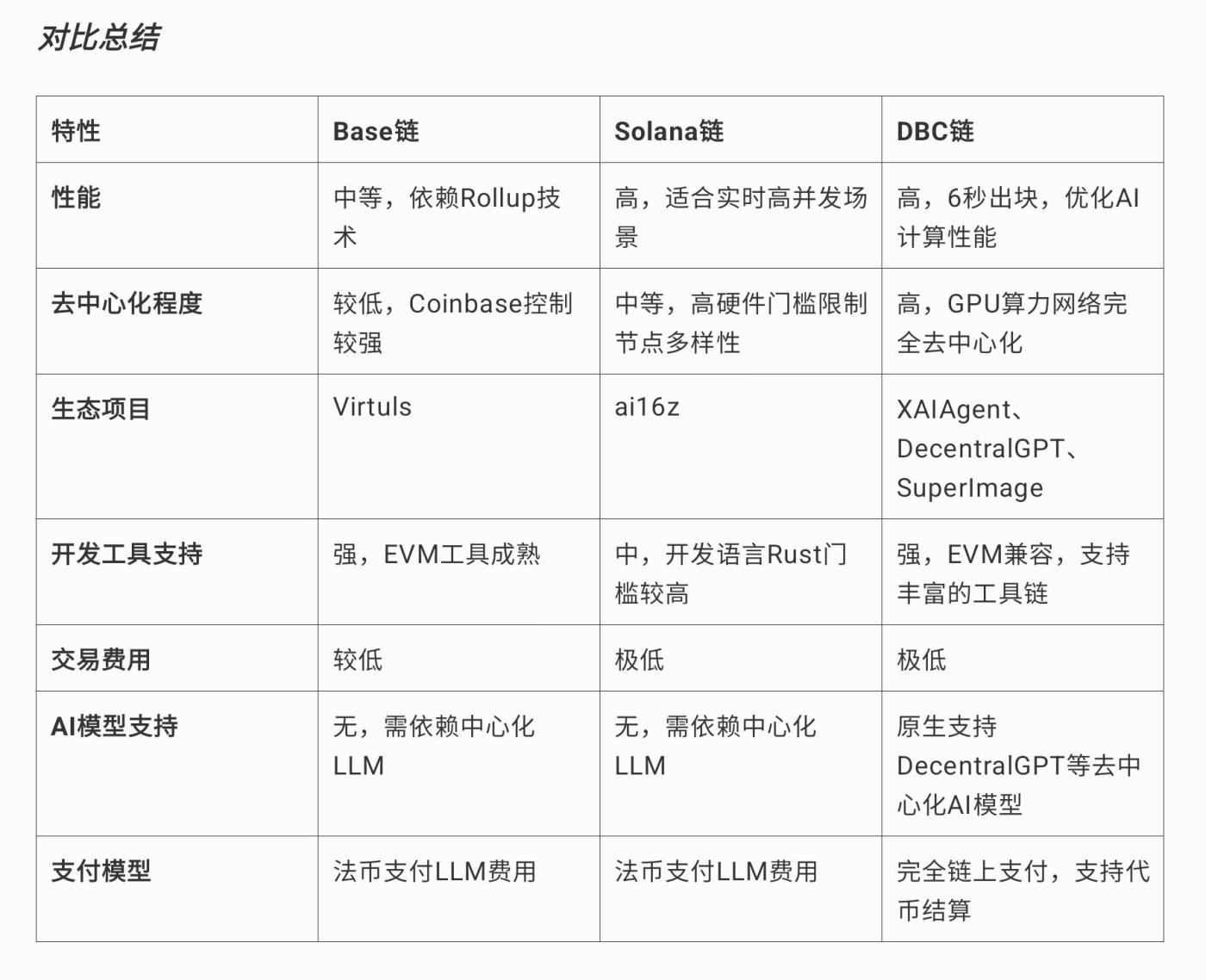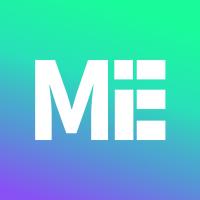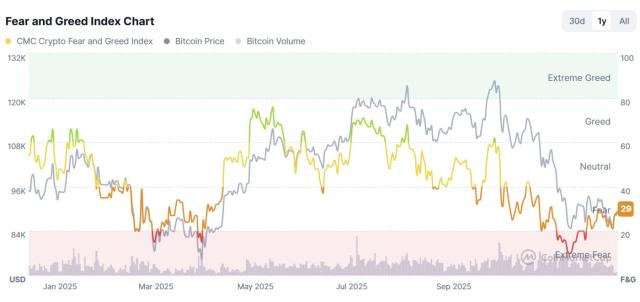This article, combining specific ecosystem projects (such as Virtuls, XAIAgent, DecentralGPT, etc.), analyzes the advantages and disadvantages of these three chains in terms of performance, decentralization, ecosystem support, and AI model integration.
Author: DeepBrain Chain
The rapid development of AI Agent technology has injected new vitality into the Block chain field, and different Block chain platforms are building their own AI Agent ecosystems. Base Chain, Solana Chain, and DBC Chain (DeepBrain Chain) have their own characteristics in terms of technical architecture and ecosystem layout. This article, combining specific ecosystem projects (such as Virtuls, XAIAgent, DecentralGPT, etc.), analyzes the advantages and disadvantages of these three chains in terms of performance, decentralization, ecosystem support, and AI model integration.
1. Base Chain: A Representative of High Compatibility and Ecosystem Integration
Advantages
1. Deep compatibility with the Ethereum ecosystem
Base Chain is based on Optimism Rollup technology, fully compatible with the Ethereum Virtual Machine (EVM), providing a convenient development environment for projects like Virtuls. Developers can use mature Ethereum development tools (such as Hardhat, Remix) to quickly build AI Agent platforms.
2. Lower transaction fees
Base Chain significantly reduces transaction costs through Rollup technology, allowing platforms like Virtuls to launch and trade AI Agents at a lower cost.
3. Abundant ecosystem resources
Base Chain inherits the large user base and ecosystem resources of Ethereum, providing a fertile ground for the rapid development of AI Agent projects.
Ecosystem Project Case
Virtuls: An AI Agent launch and trading platform based on Base Chain, providing full-process support from AI Agent creation to on-chain trading, reducing the threshold for developers to enter the AI Agent field, and providing users with a convenient way to obtain AI Agents.
Disadvantages
1. Dependence on centralized LLM (Large Language Model)
Base Chain lacks decentralized AI model support, and AI Agents need to rely on centralized LLM (such as OpenAI), with high and uncontrollable operating costs. Additionally, these models require off-chain fiat currency payments, making it difficult to achieve fully on-chain operations.
2. Centralization controversy
Base Chain was launched by Coinbase, and its governance model has been subject to a certain degree of centralization criticism.
3. Insufficient native support for AI
Base Chain is mainly a general-purpose smart contract platform, lacking native support for the operation and optimization of AI Agents.
2. Solana Chain: The Optimal Choice for High Performance and Low Latency
Advantages
1. High performance and low latency
Solana is known for its high TPS and low latency, making it very suitable for AI Agent applications with high real-time requirements. Platforms like ai16z can leverage Solana's technical advantages to achieve real-time on-chain analysis and interaction.
2. Extremely low transaction fees
Transaction fees are almost negligible, making it suitable for AI Agent applications with frequent interactions, such as dynamic analysis and forecasting.
3. Diverse ecosystem support
Solana has a large number of projects in areas such as DeFi, Non-Fungible Token, and Web3 games, providing AI Agents with rich cross-domain application opportunities.
Ecosystem Project Case
ai16z: A decentralized investment analysis platform driven by AI based on the Solana Chain, leveraging Solana's high performance and low cost to provide users with real-time market insights.
Disadvantages
1. Dependence on centralized LLM
Similar to Base Chain, the AI Agents on Solana Chain need to rely on centralized off-chain LLM for operation, with high costs and an inability to achieve full decentralization.
2. Relatively low degree of decentralization
Solana has high hardware requirements for nodes, which limits the diversity and distribution of nodes to some extent.
3. Network stability issues
Solana has experienced multiple downtime incidents, which is a major challenge for AI Agent projects that require high stability.
3. DBC Chain: A Full-Stack Solution for Decentralized AI Agents
Advantages
1. Native support for AI models and AI Agents
DBC Chain supports multiple decentralized AI model projects, such as DecentralGPT, SuperImage, and DeepVideo. These models can be directly deployed on the chain, providing fully decentralized AI inference and computing support, and providing a powerful infrastructure for the operation and optimization of AI Agents.
2. Support for EVM and fast block generation
DBC Chain is fully compatible with EVM and provides efficient transaction confirmation at a rate of one block every 6 seconds, allowing developers to use Ethereum ecosystem tools to quickly develop and deploy AI Agent projects.
3. Decentralized GPU computing network
DBC Chain establishes a decentralized computing network through miners' GPU computing power, providing low-cost computing capabilities for AI Agents, significantly reducing development and operating costs.
4. Extremely low transaction fees
DBC Chain has extremely low transaction fees, making it very suitable for AI Agent projects that require frequent model calls.
Ecosystem Project Case
XAIAgent: An AI Agent launch, use, and trading platform based on the DBC Chain. XAIAgent not only supports the creation of AI Agents, but also provides efficient access and use of AI Agents through on-chain deployment and trading functions, while offering a fully decentralized payment and settlement method.
DecentralGPT: A decentralized large language model that provides economical and controllable on-chain inference services for AI Agents, breaking free from the dependence on centralized LLM.
SuperImage: A decentralized on-chain image processing model that provides image generation and optimization services for AI Agents.
DeepVideo: A video processing AI model that provides services in the field of video analysis and media processing for AI Agents.
Disadvantages
1. The ecosystem is in an early stage
Although DBC Chain has significant technical advantages, its ecosystem projects and user base are still in need of further development compared to Base Chain and Solana Chain.
2. Cross-chain compatibility needs to be strengthened
Although it supports EVM, its interoperability with other mainstream chains (such as Solana, Ethereum) still has room for improvement.
Comparative Summary

Conclusion and Recommendations
1. Base Chain is suitable for teams that want to quickly deploy AI Agents in the early stage, such as Virtuls. Its compatibility with Ethereum provides convenience, but the dependence on centralized LLM and uncontrollable operating costs limit its further development.
2. Solana Chain is suitable for AI Agent projects that require high performance, such as ai16z, but network stability and decentralization issues need to be taken into consideration.
3. DBC Chain is a full-stack solution for the AI Agent field, particularly suitable for projects that require decentralized models, computing support, and on-chain payment, such as XAIAgent and DecentralGPT, and can provide fully decentralized services at extremely low cost.
Developers should choose the appropriate platform based on project requirements to promote the healthy development of the AI Agent ecosystem.







